Joy Neal Kidney's Blog, page 61
November 10, 2021
Stars of Blue and Gold: Veterans Day Guest Blog by Anne Clare
 A family heirloom: This banner was used by author Joy Neal Kidney’s grandparents during WWII. You can read about it in her excellent book Leora’s Letters. Many thanks to Joy for allowing me to use this image!
A family heirloom: This banner was used by author Joy Neal Kidney’s grandparents during WWII. You can read about it in her excellent book Leora’s Letters. Many thanks to Joy for allowing me to use this image!One hundred and three years ago today, “The War to End All Wars” ended. The armistice that brought about the end of World War I went into effect in 1918 on November 11, 11 a.m.
Several nations still mark this day and use it as a chance to remember this significant event. In places like Canada and Britain, it is known as “Remembrance Day.” In the United States, our calendars mark every 11/11 as “Veterans Day.”*
People observe this day and honor those who serve in various ways—ceremonies, moments of silence, creating displays featuring red poppies.
 Our students have been working on a display recognizing veterans in our school families, and my Art students will be creating projects featuring poppies this week.
Our students have been working on a display recognizing veterans in our school families, and my Art students will be creating projects featuring poppies this week.Along with this day of remembrance, the years of World War I also gave rise to another symbol to recognize those who served and sacrificed: the blue star and gold star banners.
This tradition was brought back to my attention when driving through Bremerton, WA. While some towns I have visited have flower baskets or decorative banners hanging from light posts on the streets, when I took the exit into Bremerton I noticed these.

The blue star banner was designed and patented in 1917 by Robert L. Queisser. Queisser was a veteran himself, and he had two sons serving overseas. The banners became quite popular. Bearing one star for each family member serving in the armed forces, these banners decorated the windows of homes.
Farther down the road into Bremerton, several banners hang bearing gold stars. In 1918, President Woodrow Wilson approved the practice of mothers who had lost a child to the war adding a gold star to their black mourning armband. The stars on the banners also took on a new significance as families who had lost loved ones to the war began adding gold stars over the top of the blue to mark their ultimate sacrifice.
The banners increased in popularity during World War II. In fact, the banner pictured at the top of this article is the banner used by Joy Neal Kidney’s family in WWI, repurposed by her grandmother to be used again during WWII while her five sons served.
 Another image of Joy Neal Kidney’s grandmother’s banner. Again, thank you, Joy!
Another image of Joy Neal Kidney’s grandmother’s banner. Again, thank you, Joy!Use of these banners fell off in the following decades, during the wars in Korea and Vietnam. However, they’ve received increased interest since 9/11, and the Blue Star Banner Program, which encompasses not only Bremerton, but several other Washington cities, seeks to use them again to publicly remember and recognize local people who are serving and have sacrificed. Their site, bluestarbanner.org, tells the story of this program, and shares the individual stories of the men and women who are recognized with these banners.
On this Veterans Day, I’m so thankful for the chance to stop and appreciate—for a moment at least—our hard-won freedoms, and to thank God for those who sacrificed to preserve them.
—–
*Originally, Veterans Day was named “Armistice Day.” This changed in 1954. The U.S. Department of Veterans Affairs has an informative article on the history of the day.
For more information, here are some other interesting sources
about Robert Queisser and with more facts about the Blue Star Banner from the American Legion
Anne Clare is the author of two fascinating historical novels about WWII: Whom Shall I Fear? and her brand new one, Where Shall I Flee?
Her website (The Naptime Author) and her Amazon Author page.
The Wilson family service flag is now owned by the Dexter Historical Museum, Dexter, Iowa.
November 8, 2021
Grandma Leora’s Seven Younger Brothers
 Sherd and Laura Goff family, taken July 4, 1907, Audubon, Iowa. Back: Jennings, Georgia, Merl, Leora, Wayne, Rolla. Front: Ruby, M.S. “Sherd,” Perry, Clarence, Laura, Willis.
Sherd and Laura Goff family, taken July 4, 1907, Audubon, Iowa. Back: Jennings, Georgia, Merl, Leora, Wayne, Rolla. Front: Ruby, M.S. “Sherd,” Perry, Clarence, Laura, Willis.By 1911, when he bought a farm at Wichita, Iowa, Sherd Goff would not allowed his older children to go to high school.
The three oldest sons–Merl, Wayne, and Jennings (born in 1892, 1893, and 1896)–were farming when drafted in WWI.
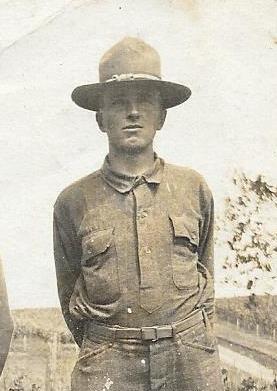

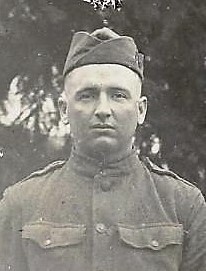 Guthrie CenterWhile their sons were still in France, Sherd and Laura bought a Victorian house in the county seat town of Guthrie Center. I know very little about Rolla (born in 1898), the middle Goff son. The photo below is from WWII.
Guthrie CenterWhile their sons were still in France, Sherd and Laura bought a Victorian house in the county seat town of Guthrie Center. I know very little about Rolla (born in 1898), the middle Goff son. The photo below is from WWII.  Rolla Goff
Rolla GoffThe three youngest sons were allowed to attend high school–Willis, Perry, and Clarence.
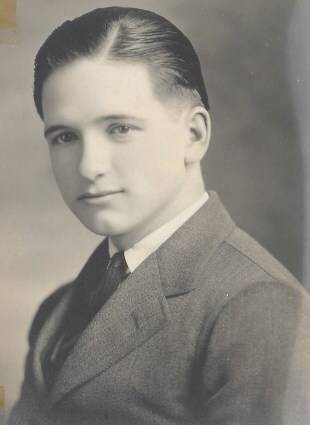 Perry Alfred Goff (1903-1982) “Played the horses” and became a waiter in restaurants from New York City to Florida.
Perry Alfred Goff (1903-1982) “Played the horses” and became a waiter in restaurants from New York City to Florida.Perry dropped out as a sophomore, shortly after he had an appendicitis attack. He also worked late at Cronk’s Cafe and it was hard for him to get up in the morning, so his dad kicked him out of the house–not an uncommon occurrence in this household.
Their Only High School Graduates
Willis was 21 when he finally graduated! But when they lived on the farm, his father had only allowed him to go to school in the winter. Clarence–the seventh son as my grandmother pointed out–was just 17 and the youngest in his class when he became their valedictorian. He was awarded a scholarship but they decided he was too young to take advantage of it, so Willis used it and studied chemistry at the University of Iowa. Willis Walter Goff (1902-2001) 1923 graduate of Guthrie Center High School. Owned a business in Southern California. Married and had two daughters–Connie and Shirley.
Willis Walter Goff (1902-2001) 1923 graduate of Guthrie Center High School. Owned a business in Southern California. Married and had two daughters–Connie and Shirley.Having that high school education was a big benefit to these two brothers. They were the most successful ones out of a family of ten. Willis went into cosmetics in Southern California.
 Clarence Zenas (C.Z.) Goff (1905-1989) 1923 valedictorian of Guthrie Center High School. Became President of Timkin heating and cooling company. After riding the rails for a while, Clarence (C.Z.) eventually became owner of a heating and cooling company (Timpkin) in Omaha, and was really able to see the extended family through the Depression. When their father died in 1930, C.Z. bought a house so that Laura, Jennings (a widower) and his children, and oldest brother Merl could move to Omaha. He also provided jobs to Jennings and Merl, and regularly helped out his sister’s growing family during those bleak years.
Clarence Zenas (C.Z.) Goff (1905-1989) 1923 valedictorian of Guthrie Center High School. Became President of Timkin heating and cooling company. After riding the rails for a while, Clarence (C.Z.) eventually became owner of a heating and cooling company (Timpkin) in Omaha, and was really able to see the extended family through the Depression. When their father died in 1930, C.Z. bought a house so that Laura, Jennings (a widower) and his children, and oldest brother Merl could move to Omaha. He also provided jobs to Jennings and Merl, and regularly helped out his sister’s growing family during those bleak years.
These Goff brothers were my mother’s uncles, who visited their mother and oldest sister (my Grandma Leora) regularly at Guthrie Center, Iowa.
Perry and Rolla were the only two I don’t remember. They never married, but arranged to have their remains sent home from the east coast for my grandmother to bury.
Merl seemed to love arguing about politics. Wayne and Willis were the most outgoing to young great nieces.
J.B., Rolla, and Perry died in their seventies. C.Z. lived to be 84. (Rolla and Perry are buried at Guthrie Center.)
Three brothers lived into their nineties–Wayne to 93, Merl to 94, and Willis to 99.
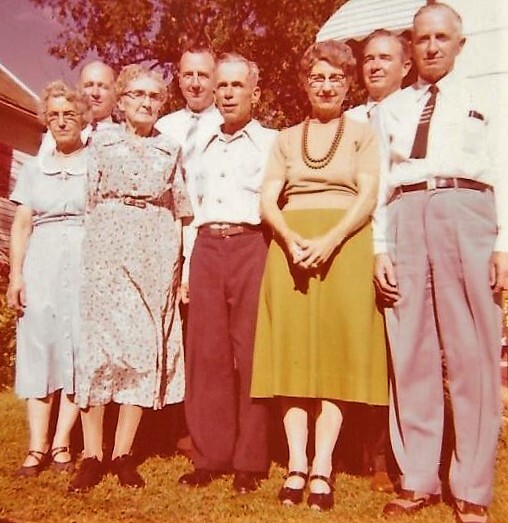 Goff siblings with their mother: Leora (Goff) Wilson, Jennings (J.B.), their mother Laura Goff, Clarence (C.Z.), Wayne, Ruby (Goff) Blockley, Willis, Merl. 1957, Guthrie Center, Iowa. Wayne, Ruby and Willis were visiting from California. Jennings and Clarence came from Omaha. (This was the only time this many got together!)
Goff siblings with their mother: Leora (Goff) Wilson, Jennings (J.B.), their mother Laura Goff, Clarence (C.Z.), Wayne, Ruby (Goff) Blockley, Willis, Merl. 1957, Guthrie Center, Iowa. Wayne, Ruby and Willis were visiting from California. Jennings and Clarence came from Omaha. (This was the only time this many got together!) Brothers Willis, Merl, and Clarence Goff with their oldest sister, Leora (Goff) Wilson. 1979, Iowa. (Willis from California, Merl and Clarence from Omaha.)
Brothers Willis, Merl, and Clarence Goff with their oldest sister, Leora (Goff) Wilson. 1979, Iowa. (Willis from California, Merl and Clarence from Omaha.)
November 3, 2021
John Busbee, Culture Buzz, Foreword for “Leora’s Dexter Stories”
Foreword by John Busbee

The sharing of personal histories introduces us to new people, places and times. Leora’s Dexter Stories: The Scarcity Years delivers a compelling narrative that stirs the embers slumbering within our memory’s hearth, enflaming a special connection between two histories – the author’s and ours. This magical blending of two worlds creates a journey both familiar and fresh for the reader. Joy Neal Kidney gives us an exceptional hybrid story of her family’s history as it unfolded during a challenging time in American history.
Leora Wilson’s family is tested during our country’s most challenging times in the 20th century: The Great Depression. Through their tenacity and caring for each other, Leora’s life is steeped in a survivalism grit, as so many other American families also endured. Kidney anchors her grandmother’s stories through oral and written remembrances of her own mother, Leora’s daughter, Doris, and her uncle, Delbert. Each chapter in Leora’s Dexter Stories: The Scarcity Years, adds to a rich, personal understanding of a time when more than a third of America suffered under harsh conditions, both economically and environmentally. Through these trials and tribulations shines this family’s unquenchable hopes and dreams, conveyed with gratitude, grace and perseverance. Just as Leora used scraps of cloth to patch bib overalls, bed clothes and dresses, Kidney lovingly stitches together a revealing historical patchwork of images, oral history, letters, news stories and more into an immensely satisfying immersion into a time that continues to resonate today.
With enough glimpses into the reality of these difficult times, Kidney provides a ground zero impact of how such economic challenges affected her Iowa ancestors. We get to know the Wilson family, its relatives of that era, friends and community members. Losses and struggles are intertwined with love and aspirations, in no small part by Leora Wilson’s determined vision for her definitions of success: her children graduating from high school and a warm, loving home wherever their family totem, the velvet “Home Sweet Home” picture, hangs. To share this journey with the Wilsons is to better understand The Great Depression, an Iowa family surviving those tempestuous times, and perhaps better understand our own family history.
Snuggle into a favorite chair with a warm cup of tea and drift into Leora’s stories as Joy lovingly channels those remembrances into a fulfilling book. Kidney feeds the flames of family, home and setting. We receive its comfort. To experience history on such a personal level feeds our souls, and we find ourselves better prepared for the now and future.
— John Busbee, The Culture Buzz, Iowa Governor’s Award for Partnership & Collaboration in the Arts, Iowa History Award for “Last Measure of Full Devotion.” He is a writer, director, musician, actor, radio host (Culture Buzz, KFMG-FM), has a weekly newsletter about anything cultural, writes for Iowa History Journal, and has a monthly column in Cityview.
The Culture Buzz website.
He’s also the bass in the GQ (Gospel Quintet)! That’s a short clip. Here’s a concert version.
I’m thankful to John for also writing a review of Leora’s Dexter Stories for the new Nov./Dec. 2021 issue of Iowa History Journal.
November 1, 2021
Striped Brown Taffeta Dress
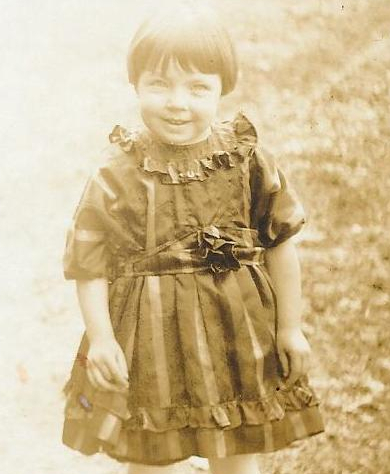
I stand on the table
in Grandmother’s dining room,
so they can pin the hem.
“Doris, turn,” say Georgie and Ruby,
again and again and again.
Sometimes a pin pricks me.
My mother’s younger sisters sew
dresses and coats for me
out of their old ones.
When I go to Sunday School,
I’m so dressed up in my Mary Janes
and a maroon coat cut from one of theirs,
with its black velvet collar.
But my very favorite is the swishy
striped brown taffeta dress
made from Aunt Georgie’s skirt.
Even when they take my picture,
I hold up a corner of the hem to
make my cheek happy.
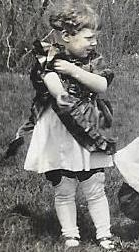
October 29, 2021
WWII Books Authored by Veterans with their Daughters
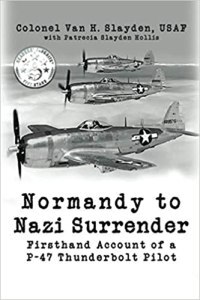
Normandy to Nazi Surrender
by Colonel Van H. Slayden with Patrecia Slayden Hollis
I’m drawn to WWII books produced by a veteran with a child or grandchild. With this one, I was expecting a war memoir, but the years from Normandy to the Nazi surrender is only about the middle third of the book.
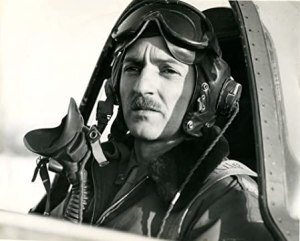 Colonel Van H. Slayden, USAF
Colonel Van H. Slayden, USAFThe best part is Slayden’s backstories, which are added as annexes: Early 1900s Life of a Tennessee Country Boy and his memories of the struggle to attend college during the Great Depression. The first chapters are also fascinating, about ending up in the military and details of flying early planes rushing into primitive areas in order to defend the Panama Canal Zone.
Slayden became obsessed with searching for the Lost Dutchman’s Goldmine when stationed in the area in 1942. He must have talked about it for decades, because later in life, he and seven family members (adult children and one of their spouses) packed into the area, even camping several nights to reach the area, to search the area where he’d filed an official claim on behalf of. There are several more miscellaneous annexes at the end, a list of sources, and a glossary.
 Patrecia Slayden Hollis
Patrecia Slayden HollisHis daughter, Patrecia Slayden Hollis , with whom he worked on the book, was born during the war, July 4, 1944.
Her LinkedIn page.
—–

LST-388: A World War II Journal
by Robert von der Osten with his daughter Barbara von der Osten

Through his journal entries, von der Osten takes us with him to war, from his training days in the newly created amphibious force, to practice beachings on the Chesapeake Bay; from the ports of North Africa and the United Kingdom, to the hostile shores of Sicily, Salerno, and Normandy. All the while serving as a radioman aboard this new kind of ship, the landing ship, tank.
I was amazed to learn that the US had shipped over 1000 locomotives and about 20,000 rail cars to the UK. Railroad tracks were welded to the deck and ramp of LST-388, and it made 29 round trips between England and France carrying rail cars. This is not only the story of a young sailor and his corner of the massive war, but the story of a ship, taking it to its eventual fate after the war. Robert von der Osten eventually served on the NYPD, then taught high school and college. Robert didn’t get his book finished, but his youngest daughter Barbara did. It has several good pictures in it and is a real treasure.
This is a wonderful memoir on so many levels. Robert von der Osten was able to keep a journal during his time of service. He and his journal not only survived the war, but his ship did. LSTs (Landing Ship Tank) were new. Von der Osten, the son of a WWI veteran, became a radioman on the new USS LST-388, which was commissioned in late 1942. The ship hauled equipment and men to North Africa, the UK, and made landings on Sicily, Salerno, and many trips to the beaches of Normandy.
I was surprised at how much traveling he was able to do when he had time off, how easily this gregarious sailor collected friends, and how grueling their days could be.
Barbara’s Amazon Author Page. LinkedIn
October 27, 2021
Santee Sioux Entered the Goff Home when Sherd was Gone
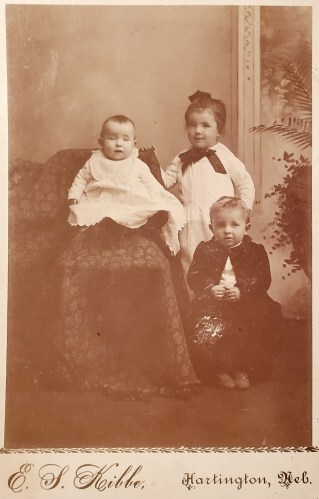 Wayne, Leora, and Merl Goff, 1893, Hartington, NE’
Wayne, Leora, and Merl Goff, 1893, Hartington, NE’This story took place near Bloomfield, Knox County, Nebraska, about two years after the photo was taken.
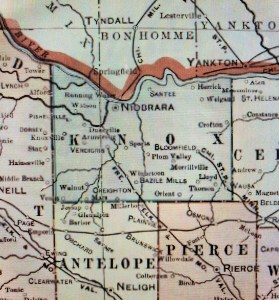
“Leora, please check on the baby, then help the boys wash up.” Merl and Wayne were about four and two years old.
Mamma, in her long dress and apron, set out bowls and spoons for midday dinner. Her sleeves were rolled up to cook at the big black stove, even in summer.
Leora, almost five, also wore a dress but she and her little brothers went barefoot all summer. The baby was still asleep in the cradle, so her big sister started for the door to call for her brothers. She noticed shadowy figures standing just inside.
Indians.
“Mamma.” Though Leora’s heart beat faster, she spoke quietly. Mamma turned from the stove, holding a large spoon.
Three men dressed in pants and shirts, just like Sherd and the other settlers. One had long black hair and wore moccasins, but the others wore boots just like Pa. One of them carried folds of cloth, in shades of red and blue. That meant they wanted to barter for something they wanted, probably chickens.
The Goffs were used to the sound of hoofbeats to signal someone arriving, or at least a knock at the door. But the Indians approached silently, as was their custom, and quietly entered a house without knocking. Laura never got used to it. Indians didn’t come often but they always startled her.
Pa said they wouldn’t hurt them but Leora knew her mother was uneasy when Indians slipped silently into the house when Pa wasn’t home.
“Go ahead and get your brothers,” Mamma told Leora.
“Those Indians?” asked Wayne.
“I told you they are.” Merl puffed out his chest.
“Hush. Yes, they’re Indians.” Leora dipped a little water from the barrel into a pan on a wooden table outside. “We’re supposed to wash up for dinner.” Merl washed his own dusty hands while Leora helped with Wayne’s grubby ones.
“Tiptoe in and sit at the table.”
“Aren’t you afraid?”
“Whisper,” she told them.
Leora helped Wayne onto a chair. The men had unfolded some of the fabric–dark prints of blue and red cotton. One man pointed outside to the pen of chickens.
Three pairs of eyes watched Mamma and the Indians.
Baby Georgia began to whimper. Leora slipped off her chair to gather her little sister out of the cradle. She stood rocking from foot to foot, patting the baby while watching her mother motion with her hand how much of the blue fabric she was willing to trade for.
“Leora, would you go out and catch a hen?” She handed the baby to her mother on her way out to the dusty chicken area. She deftly caught one by the leg and brought it to the doorway upside down, holding it by its feet. Mamma motioned to hand it to one of the men.
He turned to Mamma and held up two fingers, then pointed to the hen. Mamma paused a second during the transaction, then nodded yes. Leora soon caught another chicken, glancing up at the man’s dark eyes as she lifted it to him.
Mamma handed baby Georgia to Leora again while she found her scissors in the sewing basket. She smoothed the Indigo blue fabric and carefully cut it. She folded it as the men carried the bolts of fabric and the chickens outside.
“Hee haw hee haw.” Pa’s mules had come up to the gate. The brown visitors laughed, motioning to each other about the mules’ long ears, then left as quietly as they’d arrived.
Leora giggled behind a sun-browned hand, her speckled brown eyes shining. “Wait ‘til Pa finds out the Indians made fun of his mules.”
Mamma began to spoon some stew onto their dishes. “Wait ‘til Pa finds out how brave you are.”
Early Days at Santee: The Beginnings of Santee Normal Training School by Mary Buel Riggs, 1928.
History of the Santee Sioux: United State Indian Policy on Trial by Roy W. Meyer, 1967, 1993.
Leora (Goff) Wilson memoirs.
October 25, 2021
Discovering Key West (Minnesota)
There wasn’t much left of Key West when we visited in 2002, just a ramshackle elevator with a faint “KEY WEST, MINN.” on one side.
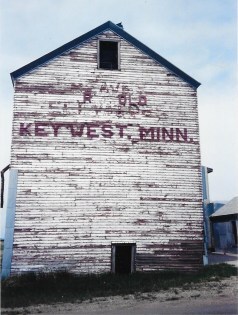
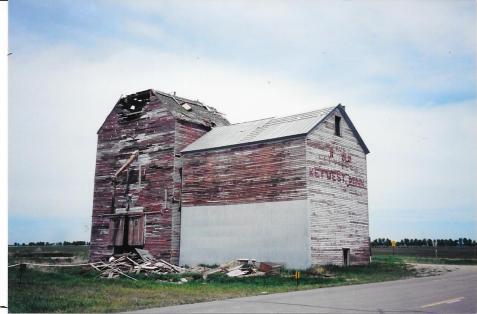
Key West had one house, a kind of community hall, and that’s about all.
The area is as flat as my Grandma Leora said it was. She said it was so flat that when she and her siblings were introduced at their new school back in 1903, the teacher announced to the students that the new Goff children had seen hills.
Leora, the oldest Goff at 12, was puzzled that the mostly Norwegian children acted jealous of this.
The huge Agassiz glacier is why that area of Minnesota is so flat. Even the 1910 plat map of Polk County shows canals or ditches every mile or so. The canals and rivers all run west, so water runs off into the Red River, then north all the way to Canada’s Hudson Bay.
The canals are still there–County Ditch 126 goes right through Key West–but the train tracks aren’t there anymore. Neither is the east-west line nor the branch that ran north and south from Key West.

The Goff family moved there from Iowa by train. Sherd and his father took livestock first. The day after they left Iowa, Laura–pregnant again–and her mother-in-law started out with the eight children. By the time they got to Grand Forks, North Dakota, to change trains, everyone but Laura had come down with colds.
 1897 Galbraith railway mail service map. Library of Congress
1897 Galbraith railway mail service map. Library of CongressThe Northern Pacific Railroad ran right through Key West and, by the time they were met there at the station–by a cutter loaded with comforters–a blizzard had come up. Leora said (in her memoirs, decades later) that arriving that way mixed up her sense of direction the whole time they lived in Minnesota.

 1902 plat map
1902 plat mapThat first September, Perry Goff was born in Polk County, Minnesota.
 1904 – Ruby, Perry, and Willis Goff
1904 – Ruby, Perry, and Willis GoffBesides raising grain and turkeys, Sherd Goff ran a threshing machine. The school children who were wary of outsiders evidently learned it from their parents. Sometimes metal objects had been secreted in the pile of grain to be threshed, in hopes that the machine would break down.
Leora described their house as being a half mile north of Key West in a grove of trees, where Sunday School picnics were held.
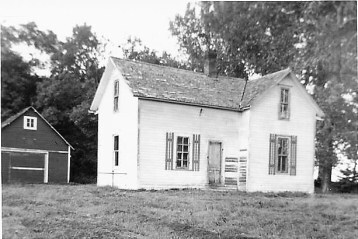

The grove is still there, but north of where I suspect the old one was, there was a new house with a dog and a swingset. No one came to the door when I knocked, hoping to learn where the old house had sat.
Google Earth shows that even the Key West elevator is gone now.
Sherd moved his family at least 13 times, seeking greener pastures. His wife was pregnant nearly every time time they moved, including to and from Minnesota. Goffs moved back to Iowa after only two years.
Has hunting for old family homes taken you to surprising places?
October 22, 2021
Two Men Who Influenced World History Grew up as Iowa Farm Boys
One man lived a clandestine life, while the other was celebrated while he was living.
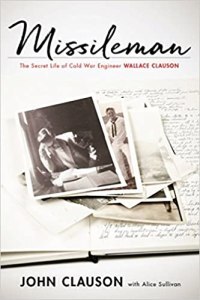
Missileman
The Secret Life of Cold War Engineer Wallace Clauson

A Cold War engineer in a Mr. Rogers sweater. What a fascinating story on several levels, with roots in small-town Iowa and a terrible accident. Wallace Clauson’s intriguing story is told around his son’s buying a house and his father’s insistence on helping build a fence and a garden. The son can barely believe his father’s revelations about the important part he’d played in world events, but memories come to him that begin to make sense. And his father is dying of cancer.
Written by his son, John Clauson, Missileman includes stories of John Atanasoff, early computers, Nuclear missiles, the Cold War, the Yom Kippur War, the Cuban Missile Crisis, secrets, Fermi, Einstein. An incredible biography.
I learned about this history through a 40-minute story on Our American Stories.
—–
General in Command
From Iowa Farm to Command of the Largest Combat Corps in World War II
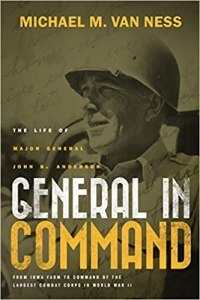
The Life of Major General John. B. Anderson, written by his grandson, Michael M. Van Ness
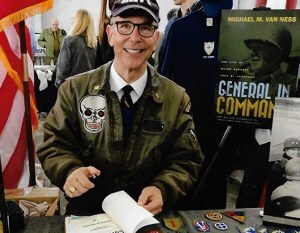
From an Iowa farm to West Point Academy. From the Mexican Incursion through World War I. Rising through the ranks, commanding an infantry division and the XVI Corps in the Battle of the Bulge and crossing the Rhine. From dining at the White House with President Harding to the Army War College with Dwight Eisenhower. From lunches with Winston Churchill to Nazi camps in Poland after the war. Amazing American history, woven with many intimate letters to his wife and daughter, written by his grandson.
I first learned about this fine history from a recent cover story about General John B. Anderson in the Sept/Oct 2021 issue of Iowa History Journal.
October 20, 2021
Arvid Huisman, Author and former Newspaper Publisher, Endorser of “Leora’s Dexter Stories”
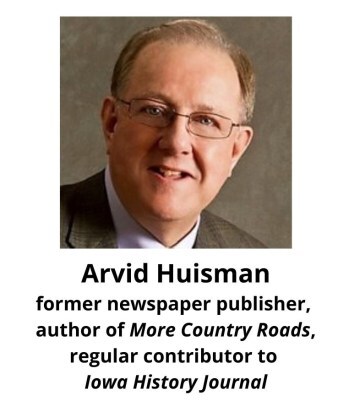
“My maternal grandparents, immigrants from the Netherlands and Germany, raised twelve children through the Great Depression. Much of who I am today was shaped by lessons my mother learned during those difficult years. Reading Leora’s Dexter Stories provided a heart-warming emotional reunion with my mother and grandmother as I recalled their related stories of dealing with disappointments, heartache and even joy in the face of adversity.
“From early in the book I was held captive by this loving and tenacious woman named Leora. The author has woven her grandmother’s story into a written tapestry that reveals Leora and her family for the reader to know and appreciate. Joy Neal Kidney’s grandmother and her letters are a testimony to the strength, devotion and creativity of Iowa’s rural women.”
 –Arvid Huisman, former newspaper publisher, author of More Country Roads, an anthology selected from more than 900 of his delightful Country Road columns, which thankfully continue today in Iowa History Journal.
–Arvid Huisman, former newspaper publisher, author of More Country Roads, an anthology selected from more than 900 of his delightful Country Road columns, which thankfully continue today in Iowa History Journal.
Retired as Director of Development, Community Relations and Media Relations for The Salvation Army in Des Moines, Arvid has had hundreds of speaking engagements, and still enjoys giving programs.
Arvid doesn’t have a website, but here’s an interesting interview with Aaron Putze from a while back.

October 18, 2021
Dallas County Freedom Rock Dedicated Two Years Ago
The Dallas County Freedom Rock was dedicated two years ago at Minburn, Iowa. The keynote speaker was Simon Conway of WHO-Radio, who is on the the Puppy Jake Foundation Board of Directors. He told compelling stories about veterans and their service dogs.
As a niece (the oldest) of the five Wilson brothers, and the book about the family due out in a few weeks, I was asked to be one of the speakers. The Freedom Rock founder and artist, Ray “Bubba” Sorensen, couldn’t attend because he beloved grandfather had died and the funeral was the same day. I was asked to lengthen what I’d planned to talk about, which was the great sacrifice of the Wilson family of Minburn during WWII. That gave me a chance to tell a little about how the Freedom Rock idea got started.
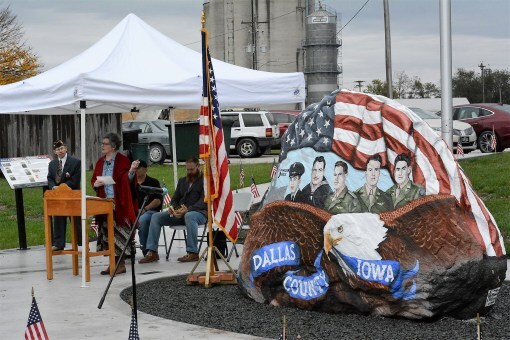
The north side features two legendary Dallas County athletes, who also served in WWII, Bob Feller and Nile Kinnick.
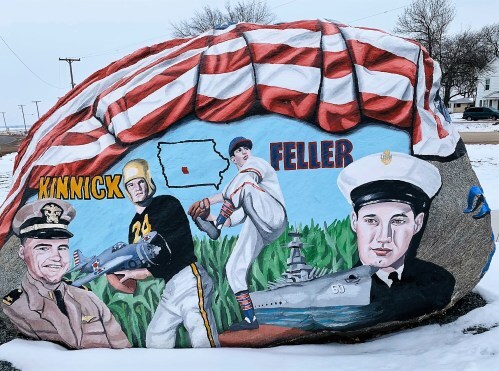
Kinnick of Adel was a football great at the U of Iowa, Heisman Trophy winner, and All American. He became a pilot during WWII, but was lost in training in the Caribbean in 1943. In 1972, the U of Iowa renamed Kinnick Stadium in his honor. (His younger brother, Benjamin Kinnick, was killed in action in 1944, in New Guinea, in a B-25. The Kinnick family, by then living in Nebraska, lost two of their three sons during the war.)
Bob Feller of Van Meter was already in the baseball major leagues when he was 17, then returned home to finish high school. (The three oldest Wilson brothers, then in school at Dexter, played against both Kinnick and Feller. Dexter lost to both.) Feller pitched 18 seasons with the Cleveland Indians, taking time out for four years of Naval service during WWII.
Five weeks later, Leora’s Letters: The Story of Love and Loss for an Iowa Family During World War II was published. (I could never have planned this perfect timing. lump in throat)
This fall, Freedom Rock founder and artist Ray “Bubba” Sorensen completed the last Freedom Rock is all of Iowa’s 99 counties. My story about Iowa’s Freedom Rocks.



